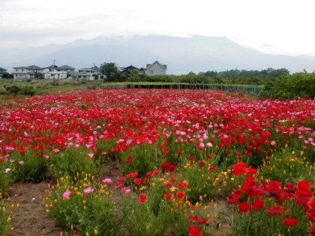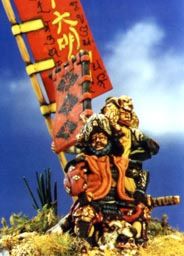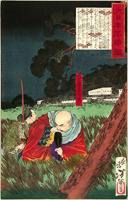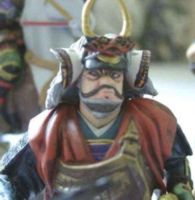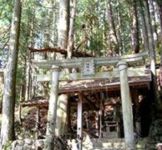THE
REAL TAKEDA
SHINGEN
& HIS KAI
TODAY
|
|
|
|
|
|
|
|
|
|
|
|
|
The Takeda clan descended from one of the mightiest clans of warriors in Japan of all times, the Minamoto clan of Kamakura. It started from Minamoto Yoshiiye's nephew, Takeda Yoshikiyo, who was a notable relative and retainer of Shogun Minamoto Yoritomo.
|
|
|
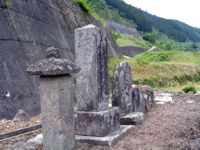 |
'Takeda' means 'warrior field', while 'Shingen' means 'new sword'. There couldn't have been a more appropriate name to address this man by. The picture at the left shows the Takeda cenotaphs. The clan virtually perished in 1582 -- the same year as the Oda calamity. |
The Takeda clan came into existence a bit earlier than the Odas. But they started out from a higher place. Takeda Governors had been the official reps of the Ashikaga shogunate in the province of Kai since 1200's, when Takeda Shingen was born in 1521. 'Shingen' wasn't always his name. When he was born, the name given to his was 'Katsuchiyo', which means 'Victory'. After coming of age, i.e. his 15th birthday, he was called 'Harunobu'. That means 'Glorious Spring' -- a nice name, but rather 'weak' compared to his dad's name, which was 'Nobutora' -- 'Grand Tiger'. They would never get along well together at any rate. Shingen wasn't daddy's boy; the old man's favorite was Shingen's little brother Nobushige. No one knew why Nobutora never liked his first son. The kid was put up for adoption as soon as he was born; taken and raised by the Obu clan. Then came Takeda Shingen's 20th birthday, and he celebrated it his own way: he attacked his daddy's castle in Shinano. Nobutora surrendered and was kicked out of Shinano at once, to get a refuge in Suruga, Imagawa clan's territory. The son he hated was now the chief of the clan. Takeda Shingen was always more warlike than everybody around, but he was also a master of tricks and deceptions since he was a kid -- that's why no one predicted his stance against his father. His first major battle, too, was won by the same trick; he pretended to have been busy supervising the digging of new moats and such, while in fact he was ready to crush a coalition of his neighbors -- the warlord clans of Ogasawara, Kiso, Murakami, and Suwa. They all were taken by surprise in 1542. Ogasawara and Murakami fled to Uesugi Kenshin's domain and begged him to whack Takeda Shingen; Uesugi, despite his 'very Buddhist' way of life (click here for Uesugi's biography and pictures), agreed to do that. Hence the boring routine war of Uesugi versus Takeda started. During which interval, Takeda Shingen also conquered the lands formerly belonging to the Tozawa in the same year, and the territory of the Takato clan in 1545. And finally, in 1551, Takeda took up the name 'Shingen' when he officially adopted Buddhism (this is something like the thing tailing catechism). The Takeda versus Uesugi borderline skirmishes, started at the much-cited 'battle of Kawanakajima' in 1553, have been made too much. Those were actually just some parade and 'exercise' for the soldiers; no one got anything out of the famous 'wars' between the two. They just marched to the same location once a year, and sat there starring at each other all day, at the end of which they all went home. What has often been overlooked was how similar Takeda Shingen and Uesugi Kenshin were. Even their names mean the same thing! They both were rather serious Buddhists, even though Uesugi was a lot more monkish than Takeda, whose monkism never went beyond donning monkish robes. Both had their excesses -- Takeda was a famous womanizer, Uesugi was famous for his equally serious approach and attachment to alcoholic beverages. Anyway, Takeda Shingen was sort of loved by the civilians of his territory, and they thought (their descendants still do, today) that Takeda was the best warlord in the Milky Way, a charismatic leader, a visionary, a scholar (he did write a book; see the Bushido page). So the clan enjoyed some close tie with a cohesive population, and the governance of the territories were smoothly done. But a karma was to happen to Takeda Shingen. In 1565, Takeda Yoshinobu, his own and (at the time) one and only son, was caught red-handedly during an attempt to assassinate the daddy. Yoshinobu wasn't killed right away, but sent to a monastery first, and only done away with 2 years later, in what appeared to be a suicide. Because Takeda Shingen's former foster-father Obu Toramasa seemed to be approving Yoshinobu's plan, Shingen ordered him to commit seppuku, too. In 1564 Takeda Shingen did a real war against Uesugi Kenshin's vassals in Kozuke. He snatched the province from Uesugi, and a branch of the Takeda clan stayed there permanently as rulers. He also went to war against the Imagawa of Suruga, which he defeated, and the Hojo clan of Odawara, which he didn't defeat. Plus he sacked his former agreement with the young Tokugawa Ieyasu, about dividing Totomi and Suruga, which led to the tiring war of Takeda versus Tokugawa since 1568 until 1575. This was, actually, started by Tokugawa Ieyasu himself by taking up the Hamamatsu castle -- too near to Takeda's border. In the same span of time, Takeda Shingen also challenged Tokugawa's ally Oda Nobunaga, since every threat to the Tokugawa territory was a threat toward the Oda clan, and this was precisely what Takeda Shingen did by invading Mikawa, where he died, near the Noda castle, in 1573, by a bullet blindly fired by an unknown Tokugawa sniper whose order was just to shoot any Takeda around. Tokugawa soldiers were all hating Takeda Shingen personally because of the circulated stories of inhumane tortures -- which were even too cruel for the standard of the warring Japan at the time. Some of those were rumors, but some were true -- like, that Takeda Shingen boiled people alive, including POW's from the Tokugawa clan, in a huge pot filled up with oil. Tokugawa Ieyasu really found the infamous pot and literally melted it to cast away the memory. The next Takeda warlord was Shingen's fourth son, Takeda Katsuyori. The relation between Shingen and this son wasn't any better than with the late Yoshinobu. For the sake of tricking the Oda clan, Katsuyori was ordered to marry Oda Nobunaga's foster daughter, who gave birth to Shingen's favorite grandkid Takeda Nobukatsu, after which she died. Katsuyori's mom was the daughter of the Suwa clan, whose chief was tricked by Takeda Shingen to sign a treaty of peace first, and only after that the man was killed; the remaining Suwa clansmen -- the chief of which was Takeda Katsuyori himself -- never forgot and never forgave Shingen for the murder. That's part of the reason why Takeda Shingen ignored Katsuyori's achievements in battle, and finally never gave him the title as the chief of the clan, which he conferred to Nobukatsu instead. Takeda Shingen's popularity as if he was the best warlord in Japan or something like an angelic ruler has been nurtured by cluelessly-made videogames and wordy web sites of the same kind. Just because Takeda was Oda Nobunaga's greatest rival, and Oda was to be put into the shoes of no lesser than Satan himself, then Takeda must be a messiah to the 'oppressed' people of rural Japan. That's something ridiculous. As you have seen, Takeda Shingen's CV was no better (and no worse) than Oda Nobunaga's. That's simply the way of the warlords in the era. Any attempt to apply 21st century caucasian Christian morality to it is absurd and pointless. |
Nagashino
War,
the Takeda Clan's Last Great Battle
![]() Movie
of the War
Movie
of the War ![]() The
Real Thing
The
Real Thing
|




